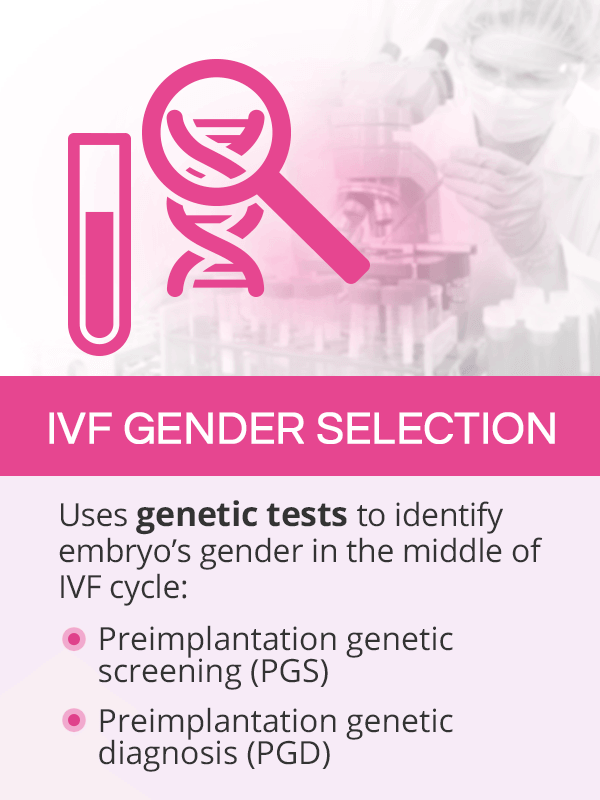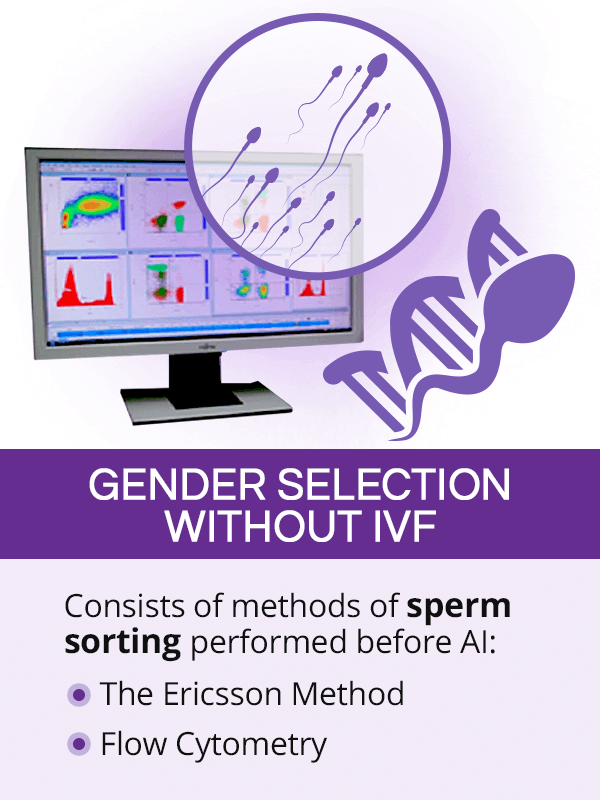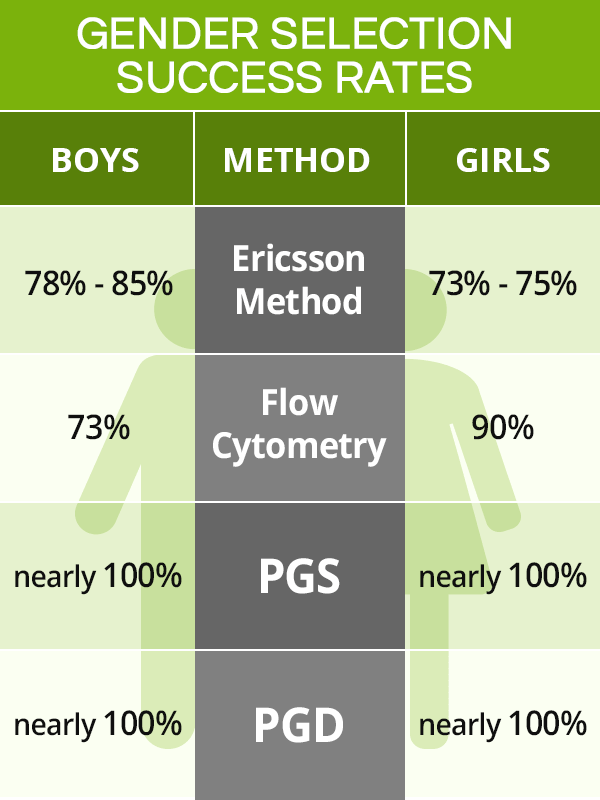What is Gender Selection?
Gender selection, also called sex selection, consists of various laboratory techniques used to isolate the sperm or embryos of a certain gender to be then used for fertilization through artificial insemination (AI) or in vitro fertilization (IVF).
Reasons for Choosing Gender of the Baby
Medical gender selection is performed to avoid the transmission of sex-linked diseases that one or both parents are carriers of. These conditions, such as hemophilia or fragile X, are inherited solely by male or female babies.
Non-medical gender selection, also called family balancing, includes cases when a couple already has a child or children of a given gender and wants the next child to be of the opposite gender. Gender selection for non-medical reasons is controversial and might not be allowed in some clinics.
Methods of Baby Gender Selection
Scientific gender selection techniques employ either artificial insemination or in vitro fertilization. They include the following:
Gender Selection Without IVF

Choosing the gender of the baby without IVF incorporates the use of less invasive artificial insemination. These techniques involve sorting female and male sperm via two methods:
The Ericsson Method. It is a sperm-sorting technique that consists of the sperm being placed in a test tube in a viscous fluid. Because male sperm have shown to swim faster, their movement can be tracked to distinguish them from the female sperm.
Flow Cytometry. This experimental technique involves staining the sperm with a fluorescent dye for differentiation. Because female sperm have been found to be slightly heavier, they appear brighter than male sperm. The most popular flow cytometry method of gender selection, trademarked as MicroSort, is awaiting FDA approval.
Once the preferred sperm are isolated, then can be used for artificial insemination, which consists of placing a thin tube into the uterus and depositing the sperm there so that they do not have to pass through the harsh vaginal environment on their way to the egg.
IVF Gender Selection

Choosing the gender of the baby with IVF is more complex and invasive. It is performed in the middle of an IVF cycle once the eggs and the sperm have been obtained and fertilized through mixing in the dish or intracytoplasmic sperm injection (ICSI).
Pre-implantation genetic screening (PGS) is a technique used to scan the embryos for an abnormal number of chromosomes, an indication of some genetic conditions, like Down syndrome. Since it gives view of the genetic material, it also reveals the gender of the embryo.
Pre-implantation genetic diagnosis (PGD) is a technique similar to PGS with the exception that PGD scans for a specific genetic condition, of which parents are carriers. As such, it also shows the gender of the baby.
Once the chosen embryo or embryos are ready, they are transferred to the uterus for implantation. The remaining unused embryos can undergo freezing, or embryo cryopreservation, for future use or embryo donation.
Gender Selection Success Rates

While individual methods of choosing the gender of the baby vary in their effectiveness, their statistics are generally high. IVF gender selection is more effective as its techniques are more precise and complex in comparison to those employed in gender selection without IVF.
It is important to remember the following gender selection success rates are not the same as pregnancy or live birth rates as these depend on a number of other factors.
Ericsson method offers a 78% to 85% chance for conceiving a boy and a 73% to 75% for conceiving a girl.
Flow cytometry claims to be 73% effective in the case of trying to get pregnant with a boy and 90% effective when trying for a girl.
Both PGS and PGD have nearly 100% effectiveness in choosing the sex of the baby.
Gender Selection Cost

Generally, the cost of various gender selection methods increases with their effectiveness. Although insurance companies might offer coverage for assisted reproductive technologies (ARTs), they might not cover the cost of choosing gender of the baby, especially if performed for non-medical reasons.
Ericsson method: $600 - $1,200
Flow cytometry: $2,500 - $3,000
PGS: $3,000- $6,000
PGD: $3,000- $6,000
It is important to remember that the aforementioned costs are in addition to the cost of pursuing AI or IVF. A single artificial insemination cycle can cost from $400 to $1,000, while an average price for one in vitro fertilization cycle is $12,000. Fertility pills and injections for ovarian stimulation can range from $1,000 to $6,000.
Conclusions
While methods of gender selection can be of tremendous importance for couples with certain genetic conditions that would otherwise be passed to their children, choosing the gender of the baby for non-medical reasons is the cause of heated debate among fertility specialists.
Some claim that using these techniques for family balancing is unethical and might lead to an imbalance in the natural ratio between genders. There is also the question of what to do with healthy embryos that have not been used because of their gender. Its proponents, however, argue that having a say in choosing the sex of the baby is a couple's reproductive right, and Western countries are far from being at risk of skewing gender ratios. Nevertheless, it is important for aspiring parents to engage in thorough research about gender selection to make educated decisions about one's family.
Sources
- Facts, Views & Vision. (2010). Preconception sex selection for non-medical and intermediate reasons: ethical reflections. Retrieved April 3, 2019 from https://www.ncbi.nlm.nih.gov/pmc/articles/PMC4086011/
- Fertility and Sterility. (2015). Use of reproductive technology for sex selection for nonmedical reasons. Retrieved April 3, 2019 from https://www.fertstert.org/article/S0015-0282(15)00240-X/fulltext
- Embryo Project Encyclopedia. (2011). Ethics of Designer Babies. Retrieved April 3, 2019 from https://embryo.asu.edu/pages/ethics-designer-babies
- International Journal of Fertility and Sterility. (2017). Chances to Have A Boy after Gender Selection by Pre-Implantation Genetic Screening Are Reduced in Couples with only Girls and without A Boy Sired by The Male Partner. Retrieved April 3, 2019 from https://www.ncbi.nlm.nih.gov/pmc/articles/PMC5134750/
- Journal of Bioethical Inquiry. (2018). Engendering harm: A critique of sex selection for “Family Balancing.” Retrieved April 3, 2019 from https://www.ncbi.nlm.nih.gov/pmc/articles/PMC5897491/
- Reproductive Biology and Endocrinology. (2014). The effectiveness of flow cytometry sorting of human sperm (MicroSoft® for influencing a child's sex. Retrieved April 3, 2019 from https://www.ncbi.nlm.nih.gov/pubmed/25420620
- Reproductive Biomedicine Online. (2010). Female gender pre-selection by maternal diet in combination with timing of sexual intercourse – a prospective study. Retrieved April 3, 2019 from https://www.rbmojournal.com/article/S1472-6483(10)00549-3/abstract
- Theriogenology. (2009). Flow cytometric sorting of human sperm: MicroSoft clinical trial update. Retrieved April 3, 2019 from https://www.ncbi.nlm.nih.gov/pubmed/18954899
- WHO. (n.d.). Gender and Genetics. Retrieved April 3, 2019 from https://www.who.int/genomics/gender/en/index4.html
